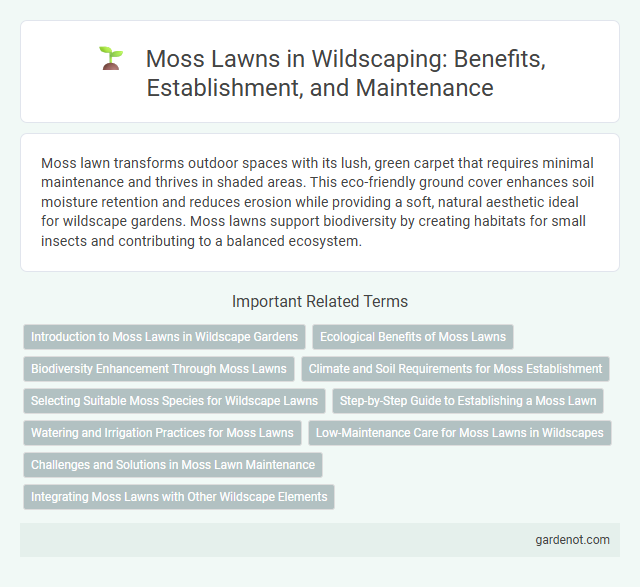Moss lawn transforms outdoor spaces with its lush, green carpet that requires minimal maintenance and thrives in shaded areas. This eco-friendly ground cover enhances soil moisture retention and reduces erosion while providing a soft, natural aesthetic ideal for wildscape gardens. Moss lawns support biodiversity by creating habitats for small insects and contributing to a balanced ecosystem.
Introduction to Moss Lawns in Wildscape Gardens
Moss lawns in wildscape gardens create vibrant, low-maintenance ground covers rich in biodiversity. These moss species thrive in shaded, moist environments, offering erosion control and natural habitat for insects and small wildlife. Incorporating moss lawns enhances the ecological balance and aesthetic appeal of sustainable garden designs.
Ecological Benefits of Moss Lawns
Moss lawns provide significant ecological benefits by enhancing biodiversity and improving soil health through natural moisture retention and air purification. Their low water requirements reduce irrigation needs, making them an eco-friendly alternative to traditional grass lawns. These moss mats also filter pollutants and support microhabitats for insects and small organisms, contributing to a balanced ecosystem.
Biodiversity Enhancement Through Moss Lawns
Moss lawns significantly enhance biodiversity by providing a unique microhabitat for various microorganisms, invertebrates, and fungi, which contribute to a balanced ecosystem. Their dense, moisture-retentive structure supports native flora and helps reduce soil erosion, promoting overall environmental health. By replacing traditional turf with moss, wildlife such as insects and small amphibians find shelter, increasing habitat complexity and ecological resilience in wildscape gardens.
Climate and Soil Requirements for Moss Establishment
Moss lawns thrive in moist, shaded environments with consistent humidity, making them ideal for temperate and subtropical climates. They require acidic to neutral soils with a pH between 5.0 and 6.5, favoring well-drained substrates rich in organic matter. Proper soil moisture and minimal disturbance ensure successful moss establishment and growth in wildscape landscaping.
Selecting Suitable Moss Species for Wildscape Lawns
Selecting suitable moss species for wildscape lawns involves evaluating factors such as shade tolerance, moisture requirements, and soil acidity. Common choices include Dicranum scoparium and Hypnum imponens, which thrive in low-light, acidic environments typical of wildscape settings. Choosing native moss species enhances ecological balance, promotes biodiversity, and ensures better adaptability to local climate conditions.
Step-by-Step Guide to Establishing a Moss Lawn
Establishing a moss lawn begins with selecting a shaded, acidic, and compact soil environment where moss thrives naturally. Prepare the site by removing grass, weeds, and debris, then lightly scoring the soil to create a textured surface for moss spores to anchor. Maintain consistent moisture through misting and avoid foot traffic to encourage healthy moss growth, ensuring a lush, low-maintenance lawn over time.
Watering and Irrigation Practices for Moss Lawns
Moss lawns require minimal watering, thriving in consistently moist but not waterlogged conditions. Irrigation practices should emphasize gentle, frequent misting or light watering to maintain humidity and prevent drying out, especially during dry spells. Avoid overwatering to prevent root rot and fungal growth, ensuring moss lawns remain lush and healthy year-round.
Low-Maintenance Care for Moss Lawns in Wildscapes
Moss lawns in wildscapes require minimal watering and thrive in shaded, moist environments with acidic soil, making them a sustainable choice for low-maintenance landscaping. These moss ecosystems naturally suppress weeds, reducing the need for herbicides and frequent mowing typically associated with traditional turfgrass. Integrating moss lawns supports biodiversity by providing habitat for microfauna and enhancing soil health through moisture retention and organic matter accumulation.
Challenges and Solutions in Moss Lawn Maintenance
Moss lawns face challenges such as excessive foot traffic, poor drainage, and competition from aggressive weeds, which can hinder their growth and overall health. Implementing solutions like aerating compacted soil, improving shade conditions, and regularly removing debris helps sustain a dense and vibrant moss cover. Choosing shade-tolerant moss species and maintaining consistent moisture levels are critical for overcoming environmental stressors and ensuring long-term lawn viability.
Integrating Moss Lawns with Other Wildscape Elements
Moss lawns complement wildscape designs by enhancing groundcover diversity and moisture retention, creating a lush, green carpet that thrives in shaded or low-maintenance areas. Integrating moss with native perennials, ferns, and shade-tolerant grasses promotes a harmonious ecosystem that supports pollinators and beneficial insects. The seamless blend of moss lawns with rocks, logs, and water features fosters natural habitat complexity and aesthetic appeal.
Moss lawn Infographic

 gardenot.com
gardenot.com